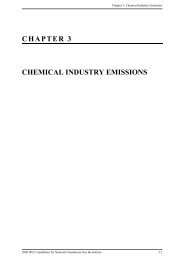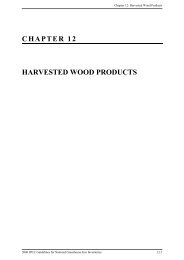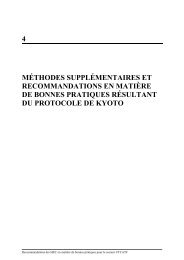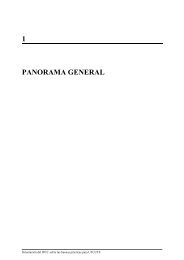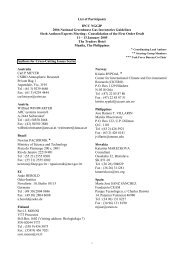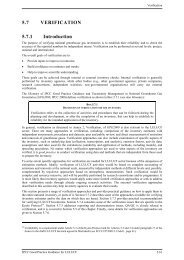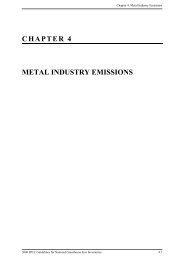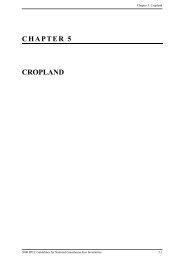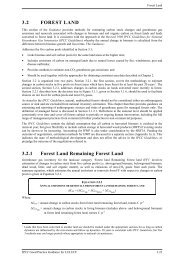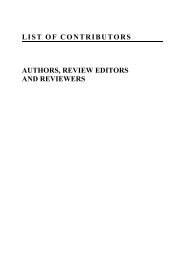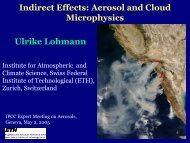Use of Models and Facility-Level Data in Greenhouse Gas Inventories
Use of Models and Facility-Level Data in Greenhouse Gas Inventories
Use of Models and Facility-Level Data in Greenhouse Gas Inventories
You also want an ePaper? Increase the reach of your titles
YUMPU automatically turns print PDFs into web optimized ePapers that Google loves.
<strong>Use</strong> <strong>of</strong> <strong>Models</strong> <strong>and</strong> <strong>Facility</strong>-<strong>Level</strong> <strong>Data</strong> <strong>in</strong> <strong>Greenhouse</strong> <strong>Gas</strong> <strong>Inventories</strong><br />
averag<strong>in</strong>g as was previously applied <strong>in</strong> the 1996 IPCC Guidel<strong>in</strong>es, or where appropriate models are available, provide a<br />
contrast model with the sources <strong>of</strong> variability excised, so as to determ<strong>in</strong>e the scale <strong>of</strong> variability.<br />
The use <strong>of</strong> models to identify the scale <strong>of</strong> <strong>in</strong>fluence <strong>of</strong> externalities on emissions estimates has been considered<br />
previously by an IPCC expert workshop as a method to factor out the non-anthropogenic effects on emissions. The<br />
meet<strong>in</strong>g ‘Revisit<strong>in</strong>g the use <strong>of</strong> managed l<strong>and</strong> as a proxy for estimat<strong>in</strong>g national anthropogenic emissions <strong>and</strong> removals’<br />
(Brazil, May 2009) considered the use <strong>of</strong> Tier 3 models to provide a comparison <strong>of</strong> two time-series <strong>of</strong> emissions<br />
estimates, with <strong>and</strong> without human activities <strong>in</strong>cluded.<br />
In this way, there are many similarities between decisions on the treatment <strong>of</strong> non-anthropogenic emissions <strong>in</strong> natural<br />
disturbances <strong>and</strong> extreme events, <strong>and</strong> the treatment <strong>of</strong> <strong>in</strong>ter-annual variability, much <strong>of</strong> which may be non-anthropogenic.<br />
Conclusions<br />
The IPCC 2006 Guidel<strong>in</strong>es provide strong guidance on the desirability <strong>of</strong> national <strong>in</strong>ventories hav<strong>in</strong>g the “...best<br />
approximation <strong>of</strong> real emissions/removals, <strong>and</strong> a time series <strong>of</strong> s<strong>in</strong>gle year estimates..... Countries should, where<br />
possible, avoid us<strong>in</strong>g multi-year averag<strong>in</strong>g <strong>of</strong> data.....” Though po<strong>in</strong>t<strong>in</strong>g to cases for exception, this clarifies the<br />
desirability <strong>of</strong> both estimat<strong>in</strong>g <strong>and</strong> report<strong>in</strong>g actual emissions on an annual basis thereby <strong>in</strong>clud<strong>in</strong>g reflection <strong>of</strong> <strong>in</strong>terannual<br />
variability as an estimation <strong>and</strong> report<strong>in</strong>g goal.<br />
Though it is preferable to reflect year-to-year variability <strong>in</strong> mak<strong>in</strong>g <strong>and</strong> report<strong>in</strong>g emissions estimates, this does create an<br />
account<strong>in</strong>g problem. When account<strong>in</strong>g considers short periods, e.g., several years, the pattern <strong>of</strong> <strong>in</strong>ter-annual variability<br />
over that period could distort the outcome so as to mask a longer term trend. In this case the account<strong>in</strong>g creates a policy<br />
problem as the pattern <strong>of</strong> <strong>in</strong>ter-annual variability is a form <strong>of</strong> a non-exceptional force majeure, a rout<strong>in</strong>e but largely<br />
unpredictable variability, mostly but not entirely beyond human control. Just as how to treat emissions from natural<br />
disturbances on managed l<strong>and</strong>s has raised account<strong>in</strong>g <strong>and</strong> policy questions, so does the consideration <strong>of</strong> nonanthropogenic<br />
components <strong>of</strong> <strong>in</strong>ter-annual variability.<br />
IPCC Expert Meet<strong>in</strong>g Report 38 TFI




